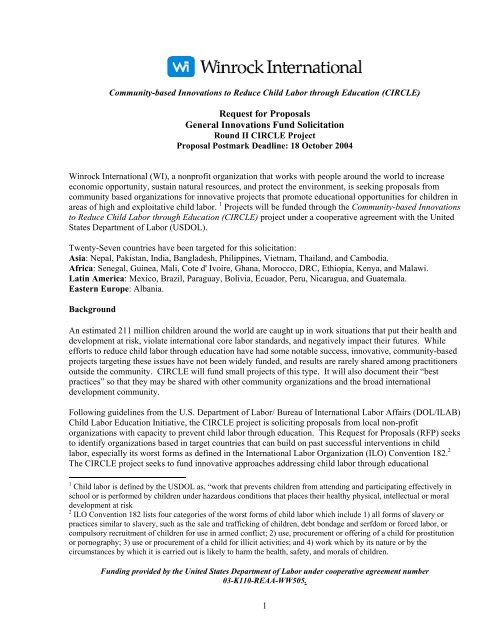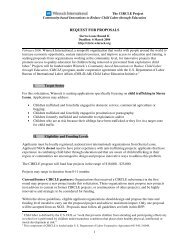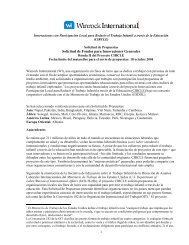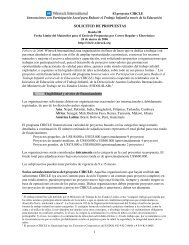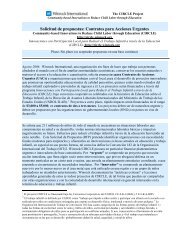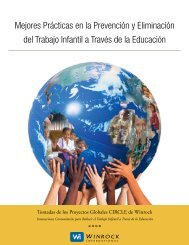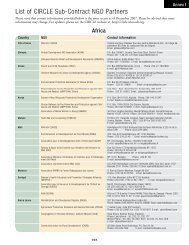Request for Proposals General Innovations Fund Solicitation
Request for Proposals General Innovations Fund Solicitation
Request for Proposals General Innovations Fund Solicitation
You also want an ePaper? Increase the reach of your titles
YUMPU automatically turns print PDFs into web optimized ePapers that Google loves.
Community-based <strong>Innovations</strong> to Reduce Child Labor through Education (CIRCLE)<br />
<strong>Request</strong> <strong>for</strong> <strong>Proposals</strong><br />
<strong>General</strong> <strong>Innovations</strong> <strong>Fund</strong> <strong>Solicitation</strong><br />
Round II CIRCLE Project<br />
Proposal Postmark Deadline: 18 October 2004<br />
Winrock International (WI), a nonprofit organization that works with people around the world to increase<br />
economic opportunity, sustain natural resources, and protect the environment, is seeking proposals from<br />
community based organizations <strong>for</strong> innovative projects that promote educational opportunities <strong>for</strong> children in<br />
areas of high and exploitative child labor. 1 Projects will be funded through the Community-based <strong>Innovations</strong><br />
to Reduce Child Labor through Education (CIRCLE) project under a cooperative agreement with the United<br />
States Department of Labor (USDOL).<br />
Twenty-Seven countries have been targeted <strong>for</strong> this solicitation:<br />
Asia: Nepal, Pakistan, India, Bangladesh, Philippines, Vietnam, Thailand, and Cambodia.<br />
Africa: Senegal, Guinea, Mali, Cote d' Ivoire, Ghana, Morocco, DRC, Ethiopia, Kenya, and Malawi.<br />
Latin America: Mexico, Brazil, Paraguay, Bolivia, Ecuador, Peru, Nicaragua, and Guatemala.<br />
Eastern Europe: Albania.<br />
Background<br />
An estimated 211 million children around the world are caught up in work situations that put their health and<br />
development at risk, violate international core labor standards, and negatively impact their futures. While<br />
ef<strong>for</strong>ts to reduce child labor through education have had some notable success, innovative, community-based<br />
projects targeting these issues have not been widely funded, and results are rarely shared among practitioners<br />
outside the community. CIRCLE will fund small projects of this type. It will also document their “best<br />
practices” so that they may be shared with other community organizations and the broad international<br />
development community.<br />
Following guidelines from the U.S. Department of Labor/ Bureau of International Labor Affairs (DOL/ILAB)<br />
Child Labor Education Initiative, the CIRCLE project is soliciting proposals from local non-profit<br />
organizations with capacity to prevent child labor through education. This <strong>Request</strong> <strong>for</strong> <strong>Proposals</strong> (RFP) seeks<br />
to identify organizations based in target countries that can build on past successful interventions in child<br />
labor, especially its worst <strong>for</strong>ms as defined in the International Labor Organization (ILO) Convention 182. 2<br />
The CIRCLE project seeks to fund innovative approaches addressing child labor through educational<br />
1 Child labor is defined by the USDOL as, “work that prevents children from attending and participating effectively in<br />
school or is per<strong>for</strong>med by children under hazardous conditions that places their healthy physical, intellectual or moral<br />
development at risk<br />
2 ILO Convention 182 lists four categories of the worst <strong>for</strong>ms of child labor which include 1) all <strong>for</strong>ms of slavery or<br />
practices similar to slavery, such as the sale and trafficking of children, debt bondage and serfdom or <strong>for</strong>ced labor, or<br />
compulsory recruitment of children <strong>for</strong> use in armed conflict; 2) use, procurement or offering of a child <strong>for</strong> prostitution<br />
or pornography; 3) use or procurement of a child <strong>for</strong> illicit activities; and 4) work which by its nature or by the<br />
circumstances by which it is carried out is likely to harm the health, safety, and morals of children.<br />
<strong>Fund</strong>ing provided by the United States Department of Labor under cooperative agreement number<br />
03-K110-REAA-WW505.<br />
1
initiatives that have a grassroots connection to children, teachers, parents, and local communities. <strong>Proposals</strong><br />
will be considered from local non-governmental organizations (NGOs) to either build on current programs<br />
and initiatives, or to propose start up pilot projects that address the relationship between education and ef<strong>for</strong>ts<br />
to reduce child labor. Projects that are especially innovative in their approach will receive the highest priority<br />
<strong>for</strong> funding.<br />
Eligible Countries and Organizations<br />
Specific countries in Asia, Africa, Latin America and Eastern Europe have been selected on the basis of<br />
criteria to capture diversity, as well as their high rates of child labor.<br />
West and North Africa: Organizations that wish to apply from West and North Africa must be located and<br />
registered in one of the following target countries: Senegal, Guinea, Mali, Cote d' Ivoire, Ghana, or Morocco.<br />
East and Central Africa: Organizations that wish to apply from East and Central Africa must be located<br />
and registered in one of the following target countries: Democratic Republic of Congo, Ethiopia, Kenya, or<br />
Malawi.<br />
South Asia: Organizations that wish to apply from South Asia must be located and registered in one of the<br />
following target countries: Nepal, Pakistan, India, or Bangladesh.<br />
Southeast Asia: Organizations that wish to apply from Southeast Asia must be located and registered in one<br />
of the following target countries: Philippines, Vietnam, Thailand, or Cambodia.<br />
Latin America: Organizations that wish to apply from Latin America must be located and registered in one<br />
of the following target countries: Mexico, Brazil, Paraguay, Bolivia, Ecuador, Peru, Nicaragua, or Guatemala.<br />
Eastern Europe: Organizations that wish to apply must be located and registered in Albania.<br />
Qualifying Criteria<br />
The applicant organization must meet the following minimum criteria. The applicant must:<br />
• be a nationally-based (not international), non-governmental organization registered according to country<br />
laws and legislation (faith-based groups are also eligible and encouraged to apply);<br />
• demonstrate ability to manage sub-contracts in a sound manner (such as a bank account and an<br />
experienced accountant);<br />
• demonstrate technical knowledge, capacity, and relevant experience to address child labor and education<br />
issues;<br />
• submit a complete application with a project description that will promote CIRCLE project objectives;<br />
and<br />
• bring not less than 10% (out of the sub-contract amount) in contribution of funds (match) or assets to the<br />
project proposed.<br />
The CIRCLE Program will NOT fund:<br />
• government agencies or political organizations, or organizations that lobby the U.S. government;<br />
• activities that create profit <strong>for</strong> the organization or constitute income generating activities;<br />
• equipment that is not explicitly required to complete the work outlined in the RFP (equipment may be<br />
purchased only to support the sub-contract activities, and the sub-contractor must follow U.S.<br />
government procurement regulations);<br />
• personnel or administrative expenses that are not related to the project; or<br />
• the same activities that are financed by other U.S. Government sources or that duplicate other USDOL<br />
2
funding. DOL funded community-based NGOs are eligible to apply with innovations that have synergies<br />
and are complementary to other projects but that do not duplicate or add to the same activity.<br />
CIRCLE Project Objectives<br />
Organizations applying <strong>for</strong> funds will propose initiatives that design, build on, and promote innovative and<br />
community-based pilot projects that address the prevention of child labor through education. Projects funded<br />
by CIRCLE will contribute directly or indirectly to indicators of impact and results:<br />
• enrollment: of children by type of educational program and level;<br />
• persistence: continuation of children in school, i.e., children stay on school’s roster/re-enroll <strong>for</strong><br />
following year(s) of schooling;<br />
• transition: children move from one educational program to another or next appropriate educational<br />
program; and/or<br />
• completion: children finish an educational program.<br />
Organizations must choose one of the following as the primary objective. Additionally, organizations must<br />
specify not only how the project will impact the primary objective, but also if and how it will contribute to<br />
any of the other three objectives. Projects do not need to contribute to all of the objectives.<br />
1. Raise awareness of the hazards of child labor and the importance of education <strong>for</strong> all children. Sample<br />
activities may include creative use of media, teacher training, mentoring of youth, theater, art, curriculum<br />
development <strong>for</strong> schools, use of the internet, community focus groups, civil society groups, seminars,<br />
workshops, and town meetings. All awareness raising activities should be able to establish a link with<br />
and document reduction of child labor and increased enrollment and/or retention of children in school.<br />
2. Strengthen <strong>for</strong>mal, non-<strong>for</strong>mal, and transitional education systems that encourage child laborers, and<br />
those at risk of working, to attend school. Sample activities may include teacher trainings in relevant<br />
curriculum, proposals by community groups to support teachers in activities and/or <strong>for</strong> supplies to<br />
improve quality and relevance of teaching, vocational and in<strong>for</strong>mational technology training; labor<br />
market studies, apprenticeships, school to work programs, on-site teacher training, health interventions<br />
that directly impact a working child’s school attendance and per<strong>for</strong>mance, civics, engendering<br />
voluntarism and student community participation, or alternative relevant curriculum that provides basic<br />
skills and education <strong>for</strong> at risk children, drop outs, and children in work situations.<br />
3. Strengthen national institutions and policies on education and child labor. Sample activities may<br />
include training and establishing dialogue with public officials, local leaders, law makers, and<br />
en<strong>for</strong>cement agencies on the hazards of child labor and the benefits of education; promoting development<br />
of public programs to improve access to school, by offering alternatives such as vouchers <strong>for</strong> education,<br />
scholarships, and apprenticeships; developing materials and guidelines <strong>for</strong> improved en<strong>for</strong>cement and<br />
monitoring methods <strong>for</strong> ensuring that children removed from work are placed in and remain in<br />
educational settings.<br />
4. Ensure the long-term sustainability of these ef<strong>for</strong>ts as documented by monitoring and measuring<br />
techniques <strong>for</strong> tracking impact, including numbers and stories reflecting educational persistence,<br />
completion and prevention of child labor <strong>for</strong> at-risk children. Sample activities may include innovative<br />
methods using child-to-child programs <strong>for</strong> tracking children; improved gathering of school level<br />
statistics; parent-teacher focus groups to check frequently on the presence or absence of the child in<br />
school; peer pressure teams developed at community level to keep records on attendance and tracking<br />
incentives.<br />
These suggested activities are not exhaustive and organizations are encouraged to suggest other innovative<br />
3
approaches that fall within the four broad categories.<br />
Organizations are highly encouraged to submit proposals targeting Objective 4.<br />
Award Cycle and <strong>Fund</strong>ing Levels<br />
This is the second round of solicitations <strong>for</strong> the CIRCLE project. In this second round, two (2) RFPs are<br />
being released – the <strong>General</strong> <strong>Innovations</strong> RFP and the Target Sectors RFP. This solicitation is the <strong>General</strong><br />
<strong>Innovations</strong> RFP. (See CIRCLE web site <strong>for</strong> the Targe Sectors RFP). Only one proposal – responding to<br />
either the <strong>General</strong> <strong>Innovations</strong> RFP or the Targeted Sectors RFP - will be accepted under the CIRCLE project<br />
from an NGO. NGOs selected <strong>for</strong> award will receive a sub-contract from Winrock International to<br />
implement proposed activities. NGOs selected <strong>for</strong> award are not permitted to sub-contract the work to other<br />
organizations.<br />
The CIRCLE project will fund a variety of projects that vary in monetary size: large projects from $100,000-<br />
$250,000; medium-sized project from 10,000-$99,999; and small projects $1,000-$9,999. 3 A total of<br />
$416,000 will be awarded during this phase of the project.<br />
Sub-contracts can range from 6 months to 18 months. Organizations applying have the discretion to design<br />
and propose the duration of time and commensurate levels of funding needed to carry out the project and<br />
achieve the most impact and results.<br />
Proposal Review Process and Evaluation Criteria<br />
All proposals should follow the Technical proposal outline or Section I of the RFP on page 9. There will be<br />
three phases of proposal review including:<br />
1.) Pre-Qualification Review: Screens each proposal to ensure each of the necessary components of<br />
the proposals have been submitted. Failure to submit a completed application will disqualify an<br />
organization’s application.<br />
2.) Executive Summary Review: The Executive Summary component of each application will<br />
serve as the primary document <strong>for</strong> review and evaluation to qualify <strong>for</strong> a review of the full<br />
proposal. The Regional Selection Committees will only review an NGO’s full proposal if it is<br />
able to demonstrate the innovative nature of its projects, and judged to be competitive based on<br />
their Executive Summaries.<br />
3.) Full Proposal Review: The full proposal review will be judged on the basis of the following<br />
weighted criteria:<br />
a. Project Approach and Objective: Clear explanation of how the implementation plan will<br />
contribute to meeting CIRCLE project objectives through innovative approaches (maximum<br />
25 points);<br />
b. Sustainability of Project: Long-term provisions <strong>for</strong> implementation plan after project<br />
funding ends (maximum 20 points);<br />
c. Organizational Experience and Capacity: Organizational and professional experience<br />
related to the activity (maximum 15 points, less than 8 points in this category will rule out a<br />
candidate; see sub-contract questionnaire <strong>for</strong> more details on this criterion);<br />
d. d. Budget: Cost sharing/cost-effectiveness of budget (maximum 15 points);<br />
e. Monitoring and Evaluation Plan: Feasibility and innovativeness of an organization’s<br />
3 Organizations have a greater opportunity <strong>for</strong> funding in the small and medium categories. NGOs seeking subcontracts<br />
of the highest monetary value, should consider that at most one such contract will be awarded in this category<br />
on a regional level and projects in the range of US $100,000 - $150,000 will be most competitive in this category.<br />
4
Logical Framework, Implementation, and Monitoring and Evaluation Plan (maximum 15<br />
points); and<br />
f. Community and Child-Centered Focus: Evidence of inclusion of communities and<br />
children in the decision-making process on proposals that directly affect them; i.e.,<br />
community and child participation (maximum 10 points).<br />
Monitoring and Evaluation Component<br />
Ensuring positive impact and results on children and communities is important, so monitoring and evaluation<br />
is a central part of the CIRCLE project vision. The requirement <strong>for</strong> careful planning and monitoring aims to<br />
encourage organizations to better understand their project’s design, document its accomplishments, improve<br />
management and decision-making. The CIRCLE project will require sub-contractors to submit a<br />
comprehensive Logical Framework, and a Monitoring and Evaluation Plan, which describes how they will<br />
conduct data collection, processing, and analysis as the means to document impact, experiences, and best<br />
practices.<br />
In addition to tracking either direct or indirect linkages to school enrollment, school retention, transitioning<br />
from educational programs, and completion of a <strong>for</strong>mal or non-<strong>for</strong>mal educational program, each subcontractor<br />
will be required to identify their own project’s primary objective. They will also need to include<br />
indicators that relate directly to per<strong>for</strong>mance and success of the proposed project. These objectives and<br />
indicators should be included in the project’s Logical Framework. In the selection criteria <strong>for</strong> proposals,<br />
Winrock International requires that each project include its own monitoring and evaluation plan, including<br />
the resources to be used to collect the necessary field data <strong>for</strong> indicators selected by the project. This<br />
monitoring and evaluation plan should correlate exactly to the indicators listed in the Logical Framework.<br />
Applicants are encouraged to be simple in their approach, to use a small number of key indicators, and to<br />
collect only essential data. Please be sure to adequately budget <strong>for</strong> implementing a monitoring and evaluation<br />
plan under the proposed budget.<br />
Essential elements to be included in the monitoring and evaluation plan:<br />
• Definition/explanation of indicators and their units of measurement<br />
• Detailed description of each indicators Means of Verification (also called, "Source of Data")<br />
• Frequency and schedule of data collection<br />
• Individuals responsible <strong>for</strong>: data collection, data management, data analysis<br />
• Cost of data collection (staff time, travel, materials, etc.)<br />
• Any additional, non-quantitative impact in<strong>for</strong>mation to be collected (i.e. qualitative indicators, various<br />
participatory approaches, etc.)<br />
Selection criteria <strong>for</strong> sub-contract proposals include the quality of the project’s proposed monitoring and<br />
evaluation system, and the degree to which it corresponds with the project’s Logical Framework and<br />
CIRCLE’s overall objectives. After award, sub-contractors will be required to submit baseline data <strong>for</strong> each<br />
approved indicator. Subsequently each quarter, the sub-contractors will choose targets, or goals <strong>for</strong> the<br />
indicator data <strong>for</strong> that quarter, <strong>for</strong> their indicators, based on their experience and planned activities during the<br />
previous quarter.<br />
For more in<strong>for</strong>mation on designing a Logical Framework and Monitoring and Evaluation plan, including<br />
examples, see the RFP section of CIRCLE project’s website at: www.winrock.org/circle<br />
Regional Launch Meeting<br />
Representative(s) from NGOs that are awarded a sub-contract will be required to attend a Regional Launch<br />
Meeting (RLM) sponsored by Winrock International’s CIRCLE project. The RLM will be funded by the<br />
CIRCLE project and will be of no cost to sub-contracting organizations. The RLM will take place at the<br />
beginning of the sub-contract process in order to establish a solid and cohesive relationship between Winrock<br />
5
International and all implementing organizations that are being funded under the CIRCLE project in a given<br />
region. The RLM will provide a <strong>for</strong>um <strong>for</strong> discussing the work plans of each project, financial and<br />
administrative requirements <strong>for</strong> the CIRCLE project, monitoring and evaluation requirements, and<br />
documenting best practices at the local level. These meetings will take place in the Fall of 2004 in Mali <strong>for</strong><br />
North, Central and French West African-based NGOs; in Kenya <strong>for</strong> East and Southern African-based NGOs,<br />
Eastern European NGOs, and English West African NGOs; in Brazil, <strong>for</strong> Latin American-based NGOs, and<br />
in the Philippines, <strong>for</strong> all Asian-based NGOs.<br />
Notification and Deadlines<br />
Winrock International will notify organizations regarding the status of a proposal within ninety days of the<br />
receipt of the proposal. Additionally, Winrock has the right to reject any and all proposals that do not meet<br />
the qualifications outlined in this document.<br />
Submission of Applications and Official Languages<br />
Specific instructions <strong>for</strong> proposal submission are included on page 9. English is the official working<br />
language <strong>for</strong> the CIRCLE project. Organizations are encouraged to submit completed applications in<br />
English; however Technical proposals (Technical, Section I of this application) will be also accepted in the<br />
following languages: French, Thai, Vietnamese, Albanian, Khmer, Spanish, or Portuguese. If organizations<br />
choose to submit Section I in a language besides English, the following criteria MUST be adhered to <strong>for</strong> full<br />
consideration:<br />
• A 2-page Executive Summary of the Technical proposal must be included in English.<br />
• Section II, Financial component must be in English.<br />
TWO hardcopies of the completed applications must be postmarked by 18 October 2004 and received at the<br />
CIRCLE Regional Office no later than 15 days after the deadline, 2 November 2004:<br />
Additionally, an electronic version with the subject line “CIRCLE project-<strong>General</strong> <strong>Innovations</strong> <strong>Fund</strong>”,<br />
in Word or PDF <strong>for</strong>mat, must also be sent to the email address provided below which correlates to the<br />
regional CIRCLE office of the applicant.<br />
CIRCLE Project South Asia<br />
P.O. Box 1312<br />
Mahadevsthan, Old Baneswore<br />
Kathmandu, Nepal<br />
Telephone: 977.01.4467087<br />
circle @winrock.org.np<br />
CIRCLE Project Southeast Asia<br />
2401, 24th Floor, Jollibee Plaza<br />
Building<br />
Emerald Avenue, Ortigas Center 1605<br />
Pasig City, Philippines<br />
Telephone: 63.2.634.4999<br />
adionela@winrock.org<br />
Projeto CIRCLE América Latina<br />
Rua Dr. José Peroba, 349<br />
Edf. Emp. Costa Azul -12º andar<br />
41760-320 Salvador, Bahia/<br />
Brasil<br />
Telephone: 55.71.273-6100<br />
circle@winrock org br<br />
CIRCLE Project North and West Africa<br />
BP E 457, Imm Ali Baba ABK 2<br />
Hamdalaye ACI 2000, Apt. 106<br />
Bamako, Mali<br />
Telephone: 223.229.38.80<br />
kcisse@winrock-mali.org<br />
CIRCLE Project East and Southern Africa and<br />
Eastern Europe c/o Chako Training Centre<br />
Cargen House, First Floor, Harambee Avenue<br />
P.O. Box 49252<br />
GPO-00100, Nairobi<br />
Kenya<br />
Telephone: 254-733-524449<br />
pomondi@winrock.org<br />
6
Checklist <strong>for</strong> Submitting a Complete Proposal<br />
Winrock International has developed a checklist to assist NGOs in submitting a completed proposal.<br />
Complete Application Contains the following and or/meets the following criteria:<br />
A 2-page Executive Summary in English;<br />
Two hard copies of the completed proposal:<br />
• Submit a completed Technical component (Section I) as outlined in the RFP; and<br />
• Submit a completed Financial component (Section II) as outlined in the RFP;<br />
An electronic version of the full proposal (Sections I and II);<br />
Audit reports;<br />
Registration certificates;<br />
Logical Framework;<br />
Documentation on indirect cost rates if used by the NGO;<br />
Application mailed in time to arrive by the Prescribed Deadline;<br />
Sufficient Match Component is included;<br />
<strong>Innovations</strong> are clearly described;<br />
Demonstration of Institutional Capability;<br />
Complete and Realistic Monitoring and Evaluation Plan;<br />
Budgets are tied to Project Descriptions/Objectives; and<br />
Micro-finance activities outlined as needed project components, but cannot be budgeted or<br />
funded under CIRCLE as stipulated in the RFP guidelines.<br />
NGOs will also find additional assistance on developing a Monitoring & Evaluation Plan and Logical<br />
Framework under the RFP section of the CIRCLE website, www.winrock.org/circle.<br />
7
INSTRUCTIONS<br />
Community-based <strong>Innovations</strong> to Reduce Child Labor through Education (CIRCLE)<br />
In submitting a proposal, all applicants are required to submit:<br />
1) A duplicate Cover Sheet (provided below) should be attached to the Technical (Section I) and Financial<br />
(Section II) components of the proposal.<br />
2) Section I: Technical component (English, French, Thai, Vietnamese, Cambodian (Khmer), Albanian,<br />
Spanish, or Portuguese).<br />
3) Section II: Financial component (English Only).<br />
The technical section will be scored separately from the financial section. Only one proposal will be<br />
considered under the CIRCLE project from an NGO. Projects that are especially innovative in their approach<br />
will receive the highest priority <strong>for</strong> funding. NGOs are also not allowed to sub-contract the work to other<br />
organizations.<br />
Cover Sheet<br />
The following cover sheet should be submitted <strong>for</strong> BOTH Technical and Financial sections of all<br />
applications.<br />
An organization must specify the primary objective and related activities of its project as they correlate to the<br />
four CIRCLE Project Objectives (See page 4).<br />
The organization should also specify the funding level of sub-contract: small US $1,000-$9,999; and medium<br />
$10,000-$99,999.<br />
RFP to which you are applying: <strong>General</strong> Innovation <strong>Fund</strong> or Target Sector <strong>Fund</strong> (organizations may only<br />
submit one proposal)<br />
Proposal Title:<br />
Name of organization:<br />
Contact Person:<br />
Phone/Fax Number:<br />
Street Address:<br />
City:<br />
State/County:<br />
Postal Code:<br />
Email:<br />
Primary Objective: (identify only one out of the four CIRCLE project objectives):<br />
Sub-contract <strong>Fund</strong>ing level (small, medium or large):<br />
Sub-contract Amount:<br />
Length of proposed project:<br />
8
Community-based <strong>Innovations</strong> to Reduce Child Labor through Education (CIRCLE)<br />
Section I<br />
Technical Proposal<br />
May be completed in English, French, Thai, Vietnamese, Albanian, Cambodian (Khmer), Spanish, or<br />
Portuguese.<br />
Organizations submitting a technical proposal must follow the outline below in order to be considered.<br />
Organizations must also demonstrate their ability to manage and implement a prescribed program that<br />
correlates directly to one of the four main objectives of the CIRCLE project described under CIRCLE Project<br />
Objectives. Projects funded by CIRCLE will contribute directly or indirectly to indicators of impact and<br />
results—enrollment, persistence, transition, and completion—also described under CIRCLE Project<br />
Objectives.<br />
Full Technical Proposal Outline<br />
Full Technical Proposal (5 parts, must not exceed 20 pages excluding the Appendix)<br />
• Part I. Coversheet In<strong>for</strong>mation (1 page, <strong>for</strong>m provided on page 9);<br />
• Part II. Executive Summary (2 pages, Must be in English <strong>for</strong> all applicants. Failure to provide this<br />
component in English will disqualify an application.);<br />
• Part III. Project Narrative (11 pages, maximum score of 55 points):<br />
• Problem Statement;<br />
• Background and rationale;<br />
• Strategic approach and objectives;<br />
• Implementation and work plan;<br />
• Sustainability and Expected Outcomes – Number of beneficiaries to be<br />
reached;<br />
• Part IV. Monitoring and Evaluation Plan, with clear linkage to Logical Framework (2 pages,<br />
maximum score of 15);<br />
• Part V. Institutional Capabilities, including management and staff load <strong>for</strong> the project (2 pages,<br />
maximum score of 15); and<br />
• Part VI. Budget, which includes match funds (2 pages, maximum score of 15) Budget must be in<br />
U.S. Dollars – this may include a column <strong>for</strong> local currency as well. A sample budget and<br />
description of types of match funds is provided below. Organizations must contribute 10 % in<br />
match to their project proposals and clearly outline it in their budgets;.<br />
• Appendix I: Logical Framework (no page limit, no score will be awarded. However, failure to<br />
include in your proposal will disqualify an application).<br />
Formatting<br />
<strong>Proposals</strong> must be submitted in the prescribed <strong>for</strong>matting requirements below:<br />
• 8 ½ x 11 inch size or A4 size white paper;<br />
• 10-12 point or pitch Times New Roman font size;<br />
• Double-spaced; and<br />
• 1-inch margins.<br />
9
<strong>Proposals</strong> that do not meet the <strong>for</strong>matting requirements outlined above will not be considered <strong>for</strong><br />
review.<br />
10
CIRCLE Sub-Contracts Program Budget Template<br />
Proposal Title<br />
Name of Organization<br />
Line items Notes Unit Costs Units Total Amount<br />
1 2 3 4 5<br />
I. Salary and Wages<br />
Project Director<br />
Project Manager<br />
Sub-total<br />
II. Benefits<br />
Sub-total<br />
III. Procurement<br />
Sub-total<br />
III. Travel and Per Diem<br />
Sub-total<br />
IV. Project Activities<br />
Sub-total<br />
V. Other Direct Costs<br />
Rent<br />
Utilities<br />
Communications<br />
Translation Fees<br />
Project Supplies<br />
Sub-total<br />
Total Estimated Costs:<br />
III. Match Contributions Year One Year Two Total<br />
1.<br />
2.<br />
3.<br />
Total<br />
Notes:<br />
1. Item “costs used in the project” includes raw materials & goods costs, fuel costs, spare parts costs,<br />
inventory costs used <strong>for</strong> sub-contract project implementation.<br />
2. Salaries are based on annual rates with units meaning months.<br />
11
3. Fringe benefits are based on organizational average payments.<br />
4. Travel costs to the sites and back is reimbursed in amount of airfare, train, water transport and<br />
vehicle costs (except taxi). Airfares are paid <strong>for</strong> economy class only. Per diem payment may not<br />
exceed those provided <strong>for</strong> by the U.S. Government.<br />
5. Communication costs include telephone, fax, express mail, postage, etc.<br />
6. Consultants Services payments are based on a monthly rate with units meaning months.<br />
7. Indirect costs are based on the method of calculation of the general administrative costs.<br />
8. VAT taxes cannot be included as part of the budget. This can be considered as match <strong>for</strong> the project.<br />
9. NGOs should budget <strong>for</strong> bank fees, and employee social contributions if applicable.<br />
10. Organizations are also encouraged to budget <strong>for</strong> translation expenses in their proposed project budget<br />
if needed.<br />
Please note this is a budget template and the applicant may add or delete items that do not relate to the<br />
operations of the applicant’s organization. Only the main sub-headings, including Salary and Wages,<br />
Benefits, Procurement, Travel and Per diem, Project Activities, and Other Direct Costs have to be used in<br />
organizing budgets.<br />
Match <strong>Fund</strong>ing Policies and Procedures<br />
Since the CIRCLE project is funded by the U.S. Government, it is subject to its financial rules under the<br />
Code of Federal Regulations (CFR). Match is referred to as that portion of project or program costs not<br />
borne by the U.S. Federal Government. There are several types of match that can be provided including<br />
volunteer services furnished by professional and technical personnel, consultants and other skilled and<br />
unskilled labor that may be counted as cost sharing or matching if the service is an integral and necessary part<br />
of an approved project or program, in kind donations, and other direct funding from the sub-contractor.<br />
Basic requirements, all of which must be met, in order <strong>for</strong> contributions, including cash and third party in -<br />
kind, to be considered a cost share or match:<br />
• Are verifiable from the recipient’s records.<br />
• Are not included as contributions <strong>for</strong> any other U.S. federally-assisted project or program.<br />
• Are necessary and reasonable <strong>for</strong> proper and efficient accomplishment of project or program<br />
objectives.<br />
• Are allowable under the applicable cost principles.<br />
• Are not paid by the U.S. Federal Government under another award, except where authorized by<br />
Federal statute to be used <strong>for</strong> cost sharing or matching.<br />
• Are provided <strong>for</strong> in the approved budget.<br />
• Con<strong>for</strong>m to other provisions of CFR Section 226.23 Cost Sharing or Matching, as applicable. 4<br />
4 Please see the following website under the section titled, Cost Sharing or Matching, <strong>for</strong> the full text of all required<br />
conditions. .<br />
12
Community-based <strong>Innovations</strong> to Reduce Child Labor through Education (CIRCLE)<br />
Section II<br />
Financial Component<br />
Must be completed in English<br />
This financial and administrative component is designed to determine the ability of the organization to manage a<br />
project, and a programmatic technical component to outline the programmatic and budget activities. As a<br />
component of the RFP, prospective organizations must provide financial and administrative in<strong>for</strong>mation<br />
concerning their management policies. This in<strong>for</strong>mation assists Winrock International in determining the<br />
management capabilities of an organization and remains confidential. This score <strong>for</strong> measuring institutional<br />
capacity will be largely based on the content of the questionnaire. This section is scored separately from the<br />
technical section of the application.<br />
Sub-Contract Questionnaire <strong>for</strong> Applicants<br />
(Please attach copies of Registration Documents)<br />
Section A: <strong>General</strong> In<strong>for</strong>mation<br />
Legal Name of Organization: ____________________________________________<br />
Contact Person: ______________________________________________________<br />
Mailing Address:______________________________________________________<br />
Street Address (if different than above): ____________________________________<br />
Telephone Number: __________________________<br />
Facsimile Number: ___________________________<br />
E-mail Address: _____________________________<br />
Website Address: ____________________________<br />
1. What type of organization are you (check all that apply)<br />
Profit<br />
NGO<br />
Non-Profit<br />
Governmental<br />
Other (please explain) _________________________________<br />
2. Is your organization legally registered No Yes
If yes, when and where was your organization registered<br />
_______________________________________________________________<br />
Please provide a copy of your organization’s registration certificate.<br />
Enclosed<br />
Not enclosed (please explain)<br />
_______________________________________________________________<br />
3. What is your organization’s tax status<br />
Exempt<br />
Non-Exempt<br />
Please indicate your tax ID number: __________________________________<br />
4. Is your organization affiliated with any other organization<br />
No<br />
Yes (please explain)<br />
________________________________________________________________<br />
5. Please list the names of the following individuals (provide an organizational chart if possible):<br />
Chairman ___________________________________<br />
President/Executive Director: ________________________________<br />
Chief Financial Officer: _____________________________________<br />
Bookkeeper/Accountant: ____________________________________<br />
Treasurer: ___________________________________<br />
Secretary: ___________________________________<br />
Section B: Financial In<strong>for</strong>mation<br />
1. Enter the beginning and ending dates of your organization’s fiscal year:<br />
From (month/day): ________________ to (month/day): ___________________<br />
2. Please complete the requested in<strong>for</strong>mation (provide a copy of your most recent financial reports):<br />
Current year in<strong>for</strong>mation (indicate period): _________________<br />
Revenues: _______________________ in local currency
Expenses: _______________________<br />
Assets: _________________________<br />
Liabilities: _______________________<br />
Prior year in<strong>for</strong>mation (indicate period): _____________________<br />
Revenues: _______________________<br />
Expenses: _______________________<br />
3. Of your current year funding, how much comes from the following sources:<br />
U.S. Government <strong>Fund</strong>s (*) _________________________________<br />
National/Provincial/Local Government <strong>Fund</strong>s (specify level) ______________________<br />
Private Foundations ______________________________________<br />
Contributions/Membership Dues: ____________________________<br />
Seminars/Conferences: _____________________________________<br />
Publications: _____________________________________________<br />
Non - U.S. Sources: ________________________________________<br />
Other Sources: ____________________________________________<br />
(*) Please indicate the U.S. Government Agency (state run public authorities) financing your organization and<br />
amount received by each agency:<br />
U.S. Government <strong>Fund</strong>s: _________________<br />
Amount: ________________<br />
National/Provincial/Local Government <strong>Fund</strong>s: ____________<br />
Amount: ________________<br />
Other Sources: _____________________<br />
Amount: ________________<br />
4. Does your organization use indirect cost or overhead rates<br />
No<br />
Yes (please provide a copy of your calculations)<br />
Section C: Accounting System/Internal Controls<br />
1. What is your normal method of disbursing payments:<br />
Wire transfers<br />
Cash (please explain why)
____________________________________________________________<br />
2. How are your transactions recorded<br />
Manual ledger system – indicate ledgers used: _______________________<br />
Computerized system – indicate software used: ______________________<br />
Briefly describe how transactions are entered into your systems, i.e. preparation of request <strong>for</strong>ms, purchase orders,<br />
vouchers, etc., the approval process.<br />
___________________________________________________________________<br />
3. Are timesheets used to record employee’s time charges<br />
No<br />
Yes<br />
4. Does your accounting system have the capacity to track multiple projects<br />
No<br />
Yes<br />
5. Does your accounting system have the capacity to track project expenses against budget line item<br />
categories<br />
No<br />
Yes<br />
6. Does your organization have a written accounting policies and procedures manual<br />
No<br />
Yes<br />
7. Briefly describe your organization’s record retention policy <strong>for</strong> financial data:<br />
________________________________________________________________<br />
8. On what bases are your reports issued<br />
Cash basis Accrual basis Modified Cash<br />
9. How often are financial reports prepared<br />
Monthly Quarterly Annually Not prepared (please explain)<br />
________________________________________________________________<br />
10. Are bank accounts established in your organization’s name<br />
Yes<br />
No (please explain)<br />
_____________________________________________________________<br />
11. If required, would you be able to set up a separate bank account to handle funds received and<br />
disbursements made with the funds related to the sub-contract agreement
Yes<br />
No (please explain)<br />
______________________________________________________________<br />
12. Are monthly bank account reconciliations prepared<br />
Yes<br />
No (please explain)<br />
______________________________________________________________<br />
13. Who prepares your bank reconciliations _______________________________<br />
Does this person also issue and/or approve disbursements<br />
Yes<br />
No (please explain)<br />
______________________________________________________________<br />
14. Does your organization maintain a petty cash account<br />
No<br />
Yes<br />
Are petty cash accounts reconciled on a monthly basis<br />
Yes<br />
No (please explain)<br />
______________________________________________________<br />
Section D: Audit<br />
1. Are you audited on an annual basis<br />
Yes (please provide a copy of your most recent audit)<br />
No (please provide a copy of your balance sheet and financial statements)<br />
2. How often are audits per<strong>for</strong>med ___________________________<br />
3. Do you have an internal auditor on staff _____________________<br />
4. Have any audits had relevant findings reported<br />
No<br />
Yes<br />
If yes, please provide a copy of the findings, recommendations and management’s response.<br />
This questionnaire must be signed and dated by organization’s director AND an authorized person who has either<br />
completed or reviewed the <strong>for</strong>m; two different persons.<br />
Printed name: _________________________________
Signature: ____________________________________<br />
Title: ________________________________________<br />
Date: ________________________________________<br />
Printed name: _________________________________<br />
Signature: ____________________________________<br />
Title: ________________________________________<br />
Date: ________________________________________<br />
Seal<br />
Attached documents:<br />
1. State Registration Certificate<br />
2. Balance Sheet<br />
3. Income/expenses Report<br />
4. Recent Audit Report (if any)
Appendix I: CIRCLE Logical Framework. Please complete this framework based on your project proposal.<br />
Narrative Summary Objectively Verifiable Indicators Means of Verification Assumptions<br />
Goal (Same goal <strong>for</strong> all CIRCLE<br />
proposals)<br />
Children at risk of child labor are<br />
educated in sub-contract funded<br />
activities in target communities.<br />
Not Applicable (N/A) N/A N/A<br />
Objective (Proposal Purpose, pick<br />
only one)<br />
1). Awareness of parents and<br />
community members raised<br />
concerning the hazards of child labor<br />
and the importance of enrolling and<br />
keeping children in school.<br />
2). Local <strong>for</strong>mal and/or in<strong>for</strong>mal<br />
education systems, programs, and/or<br />
facilities improved,<br />
3). Educational and/or child labor<br />
policy issues are addressed,<br />
4). Long-term sustainability of<br />
educational child labor prevention<br />
initiatives ensured.<br />
Indicators (If objective is No.1 or<br />
2, you must use these indicators.<br />
If not please develop a set of<br />
indicators that correspond to your<br />
chosen objective)<br />
• Number of at risk children<br />
enrolled in educational<br />
programs<br />
• Number and percentage of<br />
children that persist in<br />
program (are promoted or<br />
repeat the same grade, phase<br />
or level)<br />
• Number and percentage of at<br />
risk children that make a<br />
transition to a <strong>for</strong>mal school,<br />
i.e., enroll in a <strong>for</strong>mal school<br />
program.<br />
• Number and percentage of<br />
children that complete an<br />
educational program in which<br />
they are enrolled by a<br />
CIRCLE sub-contractor.*<br />
NGOs must identify how in<strong>for</strong>mation<br />
will be gathered.<br />
Assumptions Affecting the Purpose<br />
to Goal Linkage<br />
Sub-contractors will identify the other<br />
factors required in their specific<br />
situation to achieve the sub-contract<br />
Goal.
Sub-Objectives (Outputs)<br />
Sub-contractors will specify how they<br />
will achieve the sub-contract<br />
objective(s). This is equivalent to “subobjectives”<br />
<strong>for</strong> most projects. Some<br />
shorter projects will not have a level<br />
here but will skip this row and go<br />
straight to activities below.<br />
Sub-contractors will specify indicators<br />
that will demonstrate whether their<br />
sub-objectives have been achieved.<br />
Assumptions Affecting the Output to<br />
Purpose Linkage<br />
Sub-contractors will identify the other<br />
factors required in their specific<br />
situation to achieve the sub-contract<br />
Purpose.<br />
Activities (Inputs)<br />
Sub-contractors will specify the<br />
activities required to produce their<br />
project’s Outputs.<br />
Sub-contractors will specify indicators<br />
that will demonstrate whether their<br />
Activities have been achieved. These<br />
are equivalent to “monitoring<br />
indicators” and are optional.<br />
Assumptions Affecting the Input to<br />
Output Linkage<br />
Sub-contractors will identify the other<br />
factors required in their specific<br />
situation to achieve the sub-contract<br />
Outputs.


